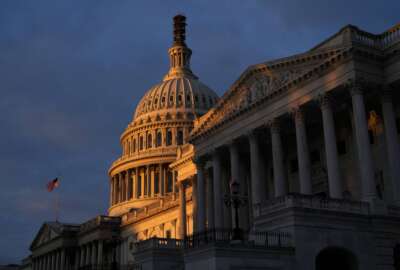
DATA Act a good thing, but implementation a struggle for some agencies
The DATA Act will make it easier for the federal government to prepare for the future and help citizens, but before it can do that, agencies need help in meeting...
The full implementation of the Digital Accountability and Transparency Act is not the end of three years of work, but the start of what oversight and accountability proponents say is a new era for the federal government.
Jason Malmstrom, assistant inspector general within the Justice Department’s audit division, said the law shows what standardized data should be and what it can do.
“The DATA Act is significant, but I think the DATA Act is also just the start,” Malmstrom said during an April 26 Data Coalition breakfast in Crystal City. “I think the DATA Act is the beginning. There are many many other data sets out there, there are many many legacy systems that have … a collection of information. The government is very very good at collecting information and data. Only recently has it begun to say well, what do we do with the data. Changing that and trying to figure out how to retrofit the systems, or build systems that better capture data is going to be the key going forward.”
The DATA Act sets new standards for federal financial information. The full roll out of the act is set for May 2017.
David Williams, former inspector general for the U.S. Postal Service, said digital analytics like big data can help keep a government current.
“Big data analytics enables government to prepare for the future and support citizens who are coping with a greatly changed world,” Williams said. “We hope that this is kind of the end of the era of stodgy and opaque government. It had better be. The world is turning at the speed of blur and governments need to be able to keep up, or it’s going to become one more casualty of creative destruction.”
The right direction
But questions remain as to whether or not agencies will make it to that starting point on time.
According to a recent GAO report, the four biggest hurdles for agencies when it comes to the DATA Act implementation are:
- Competing priorities
- Resources
- Systems integration
- Guidance
During an April 19 House Oversight and Government Reform Committee meeting, senior officials with the Treasury Department and the Office of Management and Budget told members they did not know for sure whether agencies would be prepared for implementation.
“I think that the readiness reviews that we started last week and the finalization of the guidance and schema will allow agencies to lock down their implementation plan,” OMB Controller David Mader said. “I would suspect come the end of July, August, I could probably say with a certain amount of certainty, this number of agencies are surely going to make it, and these maybe are not going to hit that exact date.”
Vijay D’Souza, director of GAO’s Center for Enhanced Analytics, said even if agencies don’t all reach full implementation on time, “we’re headed in the right direction.”
“There’s going to be benefits occurring along the way,” D’Souza said. “I do think that’s the big picture to keep in mind.”
Those benefits include information sharing between agencies, rooting out fraud and taking advantage of technology.
“The technology doesn’t do you any good without having the right data,” said Gordon Milbourn, principal at the MITRE Corporation. “The data is really the crux of the matter. The heart of the matter isn’t really around which tool an organization elects to use in its analytics. It’s more about the data and understanding it, having what data you need when you need it of the quality that’s needed, in order to use the tool or tools you have to analyze it and derive meaning out of it.”
William said there was a chance just about everyone would make it by May 2017, with the exception of the Defense Department.
“There may be others too, there will also be some people that said they made it that didn’t make it,” Williams said. “So that’s going to be a very interesting month and time.”
Malmstrom said DOJ and many other departments are struggling to balance fully implementing the law and doing it correctly.
“I think many departments’ financial shops want to stand up an analytics effort,” Malmstrom said. “The OIG community wants to. So I think there needs to be more discussion, more collaboration around that. Who should be primary on those types of efforts, it needs to be collaborative, but someone needs to have ownership. For me, from my perspective, I think the oversight agencies should have ownership of that effort, in collaboration with the departments.”
When it comes to the biggest barriers for agencies trying to implement the DATA Act, D’Souza said it’s hard to have a governance structure in place amid so many moving parts.
“This isn’t really something every agency should do in a different way or separately,” D’Souza said. “You can see throughout the government, there’s been an effort to move toward shared services and more consistent formats. I think this is just another example of that.”
Milbourn said building a data management strategy can help agencies put out fires.
“Let’s build a strategy that addresses all the key issues that they each present, let’s make sure we’re touching the points where there might be a nexus and overlap between them,” Milbourn said. “We’re also identifying perhaps some issues where gaps still remain that need to be addressed. From an organizational perspective, having a strategy that gives them an approach to logically and thoughtfully address all these things would be a very good idea.”
Copyright © 2025 Federal News Network. All rights reserved. This website is not intended for users located within the European Economic Area.





